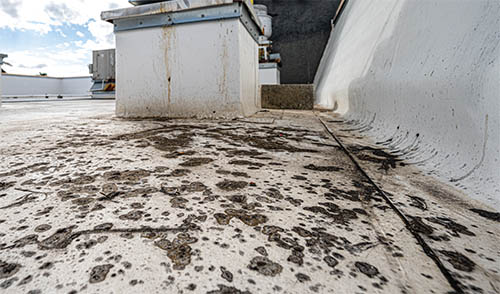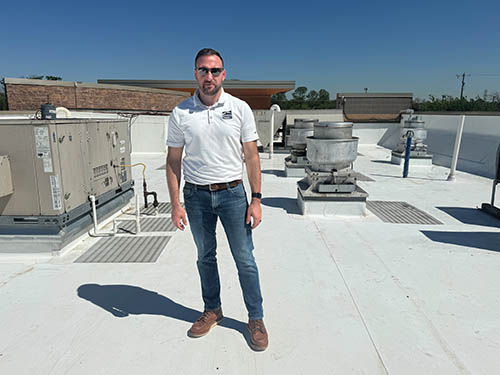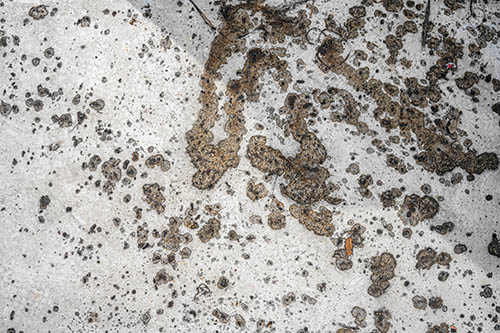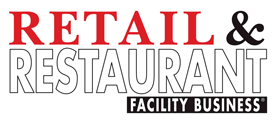— By Tom Dawson —
Rooftop grease should not be out of sight, out of mind.
For restaurant operators, inspections are a regular part of doing business. McDonald’s owner/operators have discovered that proper rooftop grease containment is a critical factor in ensuring top scores for their Running Great Restaurant (RGR) inspections.

McDonald’s owner/operators and other leading restaurant brands understand that every inspection point is important. Careful preparation across all parts of the operation is essential for achieving high scores. From general roof cleanliness to safety, McDonald’s owner/operators share how their roof and rooftop units matter not just when preparing for an upcoming RGR inspection but for keeping their restaurant operation running smoothly and safely.
Adopting best practices for rooftop preparation and grease containment can help other high-grease-producing brands prepare for their own corporate inspections as they learn from McDonald’s example. Proper grease management not only improves inspection outcomes but also protects your bottom line by extending the life of your roof and preventing costly incidents, such as grease fires or roof leaks that could lead to slip-and-fall claims.
Many operators are surprised to learn that rooftop access is part of the inspection process. Inspectors often check the condition and safety of fixed ladders, grab bars and walk pads. Imagine your maintenance crew or third-party contractors walking across a greasy rooftop. If they step in grease, it can easily transfer to the ladder and create a serious slipping hazard for the next person climbing up or down. These kinds of hazards are often overlooked but can result in safety violations, injuries or inspection penalties.

A well-maintained rooftop does more than help you pass inspections. It also protects your building and budget. Regular maintenance extends the life of the roofing membrane, which helps delay expensive capital projects like full roof replacements. It reduces the risk of rooftop grease fires and helps prevent pest infestations. Grease that remains on the membrane, especially in warm and sunny conditions, accelerates wear and tear. This leads to roof leaks that can drip inside the building, disrupting operations and creating slip hazards indoors.
Three Core Principles of Effective Rooftop Grease Management
Proper rooftop grease containment relies on three essential principles: understanding the components of your containment system, being confident in maintenance taking place on your roof and having routine trusted eyes on your rooftop.
1. Know the Limits of Your Containment System
No grease containment system is maintenance-free. Even the most advanced containment designs require regular inspection and cleaning. Grease output often changes based on season or menu updates, so it is important to ensure that your system can handle increased demand during peak times. Some operators make the mistake of assuming their current setup is “good enough” without verifying performance. Understanding the specific requirements of your system can help prevent overflows, pooling and unnoticed damage.
2. Monitor In-House and Third-Party Maintenance Practices
Grease isn’t the only threat to your rooftop. Improper cleaning practices can also cause significant damage. Your roof is a complex system made up of various interconnected components, and a solution that benefits one part may unintentionally harm another. That’s why it’s essential to work with contractors who understand how their work impacts the entire rooftop ecosystem.

For example, in-house maintenance teams should avoid using pressure washers to remove grease. High-pressure water can damage the roofing membrane, leading to leaks and costly repairs. Similarly, hood cleaning contractors often use harsh degreasers designed for metal surfaces. These chemicals can degrade roofing materials, especially if not rinsed properly, and exposure to sunlight can worsen the damage. Clear communication with every vendor who services your rooftop is key. Ensure they know which products and processes are safe for your specific roof type.
3. Schedule Routine Rooftop Service with a Trusted Partner
New products on the market often advertise reduced need for human oversight. While automation can be helpful, there are many rooftop components that still require a trained eye. A trusted service partner can identify early signs of wear, recommend adjustments and provide documentation to support your inspection readiness. Routine service visits also ensure that containment systems continue to perform as intended and remain in compliance with safety standards.
“Finding a roofing company with extreme attention to detail played a key part in helping us achieve a good cleanliness score on our RGR visits. I highly recommend to fellow restaurant operators who are preparing for a QC visit to work with a partner who understands how important it is to remediate and prevent grease damage on the roof.”
— Jennifer Yaw, McDonald’s Owner/Operator
Rooftop grease is rarely the first thing restaurant operators think about when preparing for an inspection. However, it should be added to the list. Failing to manage rooftop grease can result in lost inspection points, emergency repairs, safety incidents, and unnecessary expenses.
The best way to stay ahead is to understand your containment system, work with a trusted partner who can monitor it regularly and ensure that all rooftop unit maintenance is performed using approved methods. Taking these steps will help protect your inspection score, your building and your bottom line.
— Tom Dawson is CEO at RoofingSource and has worked on and managed thousands of projects, mastering the ins and outs of commercial roofing systems. He currently advises the nation’s leading brands on their rooftop management and roofing portfolio strategy.

